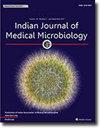Navigating the molecular landscape of Candida auris in a tertiary care setting in Eastern India
IF 1.4
4区 医学
Q4 IMMUNOLOGY
引用次数: 0
Abstract
Purpose
Candida auris was recently listed as a critical priority fungal pathogen by WHO due to its multidrug resistance and enhanced propensity for nosocomial transmission. This study investigated the molecular epidemiology and colonization patterns of C. auris in a tertiary care center in Eastern India.
Methods
A total of 201 patients from different intensive care units (ICUs) were enrolled, with colonization rates determined through enrichment followed by culture on chromogenic agar and molecular confirmation using Candida auris specific polymerase chain reaction (PCR) and antifungal susceptibility testing was done using microbroth dilution. For molecular characterization Fluorescent Amplified Fragment Polymorphism (FAFLP) was used.
Results
FAFLP revealed multiple clusters of strains, predominantly belonging to clade I, with notable isolates closely associated with clades III, IV, and V, previously unreported in India. Antifungal susceptibility testing found high resistance to amphotericin B (59.6 %) and low resistance to fluconazole compared to older studies (59.6 %), underscoring the need for further investigation. Sustained transmission of C. auris was observed despite infection control measures, emphasizing the ongoing challenges in infection control and the necessity for continuous surveillance.
Conclusion
This study contributes valuable insights into the epidemiology and genetic diversity of C. auris in Eastern India, highlighting the need for further investigations to understand transmission dynamics and clinical implications and underscores the importance of ongoing surveillance in combating this emerging pathogen.
导航念珠菌的分子景观在印度东部三级保健设置
目的耳念珠菌因具有多药耐药和院内传播倾向,最近被世界卫生组织列为重点真菌病原体。本研究调查了印度东部三级保健中心的金黄色葡萄球菌的分子流行病学和定植模式。方法选取201例不同重症监护病房(icu)患者,通过富集、显色琼脂培养、耳念珠菌特异性聚合酶链反应(PCR)确证及微肉汤稀释法进行抗真菌药敏试验,测定其定植率。分子鉴定采用荧光扩增片段多态性(FAFLP)。结果faflp检出多株毒株,主要属于I枝,与III、IV、V枝密切相关的分离株在印度未见报道。抗真菌药敏试验发现对两性霉素B的耐药较高(59.6%),对氟康唑的耐药较低(59.6%),强调需要进一步调查。尽管采取了感染控制措施,但仍观察到金黄色葡萄球菌的持续传播,这强调了感染控制方面的持续挑战和持续监测的必要性。结论本研究为了解印度东部金黄色葡萄球菌的流行病学和遗传多样性提供了有价值的见解,强调了进一步调查以了解传播动力学和临床意义的必要性,并强调了持续监测与这一新兴病原体作斗争的重要性。
本文章由计算机程序翻译,如有差异,请以英文原文为准。
求助全文
约1分钟内获得全文
求助全文
来源期刊

Indian Journal of Medical Microbiology
IMMUNOLOGY-
CiteScore
2.20
自引率
0.00%
发文量
154
审稿时长
73 days
期刊介绍:
Manuscripts of high standard in the form of original research, multicentric studies, meta analysis, are accepted. Current reports can be submitted as brief communications. Case reports must include review of current literature, clinical details, outcome and follow up. Letters to the editor must be a comment on or pertain to a manuscript already published in the IJMM or in relation to preliminary communication of a larger study.
Review articles, Special Articles or Guest Editorials are accepted on invitation.
 求助内容:
求助内容: 应助结果提醒方式:
应助结果提醒方式:


